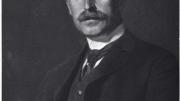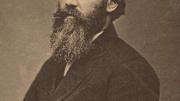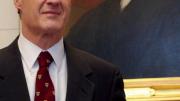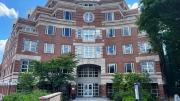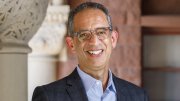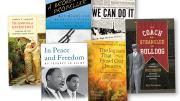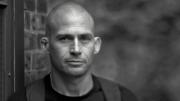Judge Learned Hand recalled that his Harvard Law School professors taught him the Spartan ethic which helped make him a legal giant. “In the universe of truth,” he said in 1958, during a public lecture, “they lived by the sword: they asked no quarter of absolutes, and they gave none.” The 86-year-old, A.B. 1893, A.M. ’94, LL.B. ’96, LL.D. 1939, exhorted law students in the audience: “Go ye and do likewise.”
The “intellectual sword,” Bruce A. Kimball and Daniel R. Coquillette recount in their excellent history about much of the school’s second century, defined the institution: its hyper-competitive student culture, its confrontational pedagogy, and its extraordinary influence on education. In the authors’ words, it is “arguably the most influential professional school in American history.” (Kimball, M.Div. ’78, Ed.D. ’81, is an emeritus professor at Ohio State University. Coquillette, J.D. ’71, is a University Professor at Boston College, a past dean of its law school, and an HLS visiting professor.) The current dean, John Manning, an alumnus, extolled that influence at the school’s bicentennial celebration in 2017. He noted that of the nation’s now-85 attorneys general since 1789, roughly one of every eight attended HLS; of the 48 solicitors general since 1870, it was one of every seven; and of the now-115 Supreme Court justices since 1789, it was about one in five, or 21.
Kimball and Coquillette’s account is not a celebration of influence, however. Instead, it is a measured, often chilling, explanation of how dependence on student tuition as the primary source of revenue, coupled with insistence on maintaining high academic standards, led to an exacting, often brutal culture, which ground out lawyers by grinding down students. The culture’s negative effects marked it as competitive to the point of being pathological. Faculty members were its agents, but also victims. In 1984, in The New Yorker, Calvin Trillin reported on severe divisions within the faculty of the school, fueled by anger and hate. He opened with this comparison between HLS and other prominent law schools made by an HLS faculty member: “Well, this is the unhappiest place.”
The Intellectual Sword is deeply researched, crisply written, and scrupulously independent. The book tells the law school’s story until a generation ago: it doesn’t cover the current era and large changes making the place happier, healthier, and better. In 2003, when Robert C. Clark, J.D. ’72, now an emeritus professor, stepped down as dean after 14 years, Coquillette told Harvard Magazine that Clark’s was “one of the major deanships in the history of the school.” His success as a fundraiser enabled him to expand its faculty, reduce the size of individual classes, and begin to change the culture as his successors have continued to do: encouragement now complements a respectful form of challenge as a fundamental of HLS teaching.
Still, vestiges of the old culture remain: the social Darwinism, stimuli for anxiety, and big-headed smugness. Kimball and Coquillette explain how stubborn that culture’s roots are, and how they kept the school from being the great institution it long, myopically, considered itself.
In 1905, as the book recounts to set up its account of the century beginning in 1917, the law school had the opportunity to change its financial model and future. It had about $900,000 for investment ($400,000 of endowment; $500,000 of cash reserves)—about nine times its annual expenses. But the school’s student body had grown sizably from around 400 in 1892 to 700 in 1903. It was overcrowded. If the school had capped enrollment at 400 and increased its tuition to $200, matching that of Harvard Medical School, it would have fit in its space and generated a financial surplus. That would have allowed it to cover about a third of expenses from investment income, yet grow moderately while maintaining a smaller faculty-student ratio.
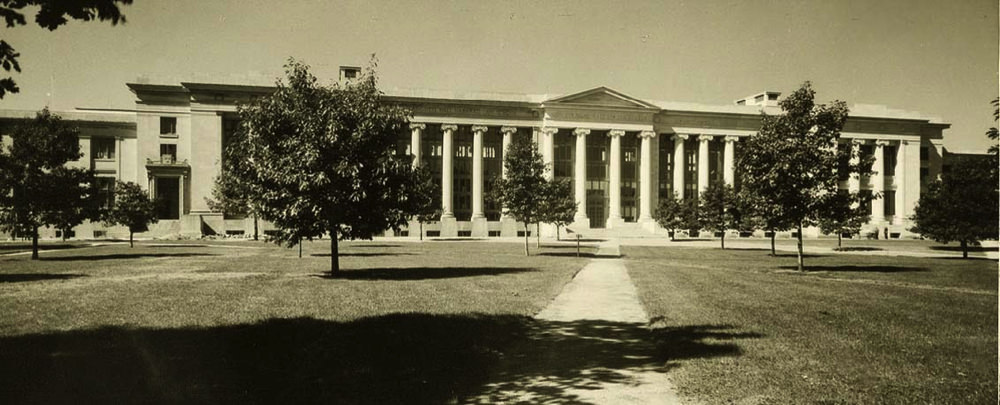
The costly Langdell Hall anchored the rising institution, but forced it into a punishing, tuition-dependent model of operation.
Paul J. Weber, Courtesy Harvard Law School Library, Historical & Special Collections
Instead the school chose to stay on its rapid-growth path by building the massive Langdell Hall (“for many years one of the largest buildings at Harvard,” the authors report). It spent $400,000 of its reserves to do so (about $10 million today). That reduced its investment income, even as the new building and continued growth increased its expenses. The result was a financial disaster, consigning the school to dependence on revenue from tuition.
Ezra Thayer, A.B. 1888, LL.B. ’91, dean from 1910 to 1915, was “the first Harvard administrator to appreciate the dire financial straits” of the school. He didn’t want to increase enrollment further, fearing that HLS would have to relax its standards by lowering the level of academic competence required of students to retain some of them, so he decided “to admit more students to the first year and then flunk more out because first-year students, who had to enroll in enormous courses, were cheaper to support.” While he was dean, between 24 percent and 36 percent of the first-year class flunked or dropped out.
The perception that HLS was wealthy because it had the biggest endowment of any university professional school in the country made the problem of tuition dependence worse: the endowment, though substantial, was not enough to keep tuition low without a large enrollment. Thayer tried to raise more money for the endowment and failed. He was a perfectionist, not well-suited to the deanship’s demands. Those duties and his disposition kept him from addressing the school’s financial problems. He became acutely depressed. As Kimball and Coquillette write, Thayer drove himself “to the brink of nervous collapse.” He committed suicide in 1915.
The story of each HLS deanship is different, but each of Thayer’s six successors until Robert Clark, three-quarters of a century later, understood, complained about, and did little or nothing to break the cycle that got worse over time: “high enrollment, high student-faculty ratio, illusions of prosperity, high fixed costs and debt, and little external support.” Tuition dependence and a wariness about relaxing academic standards led the attrition rate for first-year students to climb to an average of over 30 percent until the mid-1930s—“much higher than in elite private higher education generally,” the authors write. To the faculty, that rate was a measure of academic rigor. The “ask and give no quarter” ethos that Hand exalted, the authors write, “intensified as the school’s financial problems worsened.” The ethos “began to appear natural and necessary”—“rationalized as academically advantageous.”
To Kimball and Coquillette, HLS had five shaping leaders in its first two centuries: Joseph Story, A.B. 1798; Christopher Columbus Langdell, A.B. 1871, LL.B. ’53; Roscoe Pound, LL.D. ’20; Erwin Griswold, LL.B. 1928, S.J.D. ’29; and Clark. The authors focused on Story and Langdell in On the Battlefield of Merit (2015), about HLS during its first century, beginning in 1817.
Story was simultaneously a justice of the United States Supreme Court, a member of the Harvard Corporation, and, from 1829 to 1845, HLS’s leader (the school had no dean). He held “a position within the university so powerful that it would be unthinkable today,” the authors wrote in their first volume, not to mention the impossibility now of being a justice while dean. Story rescued HLS from oblivion, turning it into “a school for a national elite, an aristocracy not of wealth or breeding, but of intelligence, hard work, and character.”
Langdell was its first dean, from 1870 to ’95. He revolutionized legal learning with his inductive approach to teaching, by having students read judicial opinions rather than textbooks and analyze specific disputes instead of general propositions. His goal was for them to develop “the capacity and self-confidence to infer, evaluate, and formulate legal doctrine and judgments autonomously, regardless of the weight of contrary authority.” His system of legal education became America’s. It replaced slack expectations for gentlemanly learning with merit, which a student had to win on the intellectual battlefield.
Pound (dean from 1916 to 1936) and Griswold (1946-1967) embodied that Spartan ethic. Pound did so with his “high-handed demeanor and his commitment to exile those deemed unfit,” expanding the school’s student body, faculty, physical plant, and endowment while making it into what J. Willard Hurst, J.D. ’35, an esteemed legal historian, called “an excellent trade school.” Griswold “epitomized the Harvard Law School as we knew it,” in the words of Harvard president emeritus Derek C. Bok, J.D. ’54, an HLS professor from 1958 to 1968, and then its dean until 1971: Griswold was “austere, forbidding, uncompromising but ultimately commanding our grudging admiration and respect.”
Griswold doubled the size of the faculty to 67 while keeping student enrollment around 1,500, oversaw eight new buildings, and expanded the school’s academic program. He made its admissions process selective for the first time. Until then, the school had admitted any applicant with a bachelor’s degree and a grade-point average deemed high enough to give him a 50 percent chance of graduating from HLS. The new selection was based on an applicant’s college, GPA, and LSAT score, plus qualitative factors like geographic diversity, military service, and difficulties overcome. By 1950, the attrition rate fell to 7 percent. By 1965, the failure rate at the end of the first year all but disappeared.
But the selectivity made the student body even more homogeneous because most of the strongest applicants had similar socioeconomic backgrounds and college educations. Griswold also treated as a necessity, and intensified, HLS’s rat-race culture. That resulted in a profound parochialism: it was evident in the school’s preference for hiring its graduates as professors and in its refusal to admit women until long after other law schools had. In 1947, when a professor proposed admitting women, HLS “was one of only five law schools in the United States that excluded women” out of about 100 accredited schools. [See “The Education of a Harvard Lawyer,” page 38.]
Griswold is infamous for his grilling of Justice Ruth Bader Ginsburg, L ’59, in 1956, when she was one of nine women in a class of 552: as was his custom, he asked each why she was taking a man’s place at the school. That misogyny was matched by the school’s ill-treatment of her 15 years later, after it appointed her a lecturer in 1971. She was a professor at Rutgers Law School, in New Jersey, and living in New York City, so she commuted to Cambridge one day a week to teach at Harvard during the fall term. She learned that, instead of holding a soon-to-be tenure-track appointment, as promised, she was merely auditioning for a possible appointment. She was invited back to continue auditioning, but declined in favor of a tenured professorship at Columbia.
Ginsburg was the first of 19 women with temporary or visiting appointments at HLS between 1971 and 1986, of whom two got tenure. In those years, six women got tenure-track assistant professorships, of whom two “were tenured and built a career” at HLS. Its record in hiring people of color was even worse.
In their first volume, Coquillette and Kimball recounted how Langdell’s case method transformed American legal education and how the school’s large enrollment and prestige led to a plurality of American law professors being trained at HLS. That deepened its influence on legal education and scholarship, the legal profession and the law. In the second volume, the authors document a second kind of influence, the tuition-dependent financial model that stoked the combative culture. “If Harvard, the law school with the largest endowment in the world, depended so heavily on tuition reaped from huge classes,” they write, “how could other law schools justify appeals for endowment, philanthropy, or subventions”—grants—“at their universities?” The paper chase at HLS spurred similar chases at almost every other law school, with similar attrition rates and cultures. Those traits helped shape a legendarily unhappy legal profession.
The Intellectual Sword recounts an array of notable dramas, involving joy, triumph, and inspiring accomplishment, as well anti-Semitism, pro-Nazism, and spinelessness in the face of McCarthyism at HLS. The only blatant mistake I noticed is the claim that Wade McCree, LL.B. ’48, was the first African American solicitor general, in 1977: in 1965, Thurgood Marshall, the future justice, became the first black S.G. Impressive as the book is, the subtitle “the Second Century” promises that it is about HLS until 2017 and it isn’t. The story beginning with the Clark deanship and continuing through those of Elena Kagan, J.D. ’86, and 300th Anniversary University Professor Martha Minow, as well as John Manning, is about remarkable transformation. The school fundamentally revised its curriculum for the first time in 130 years, made the interests of students a top priority, and shifted its mission to be about justice as much as law. All of that is crucial to understanding HLS today.
